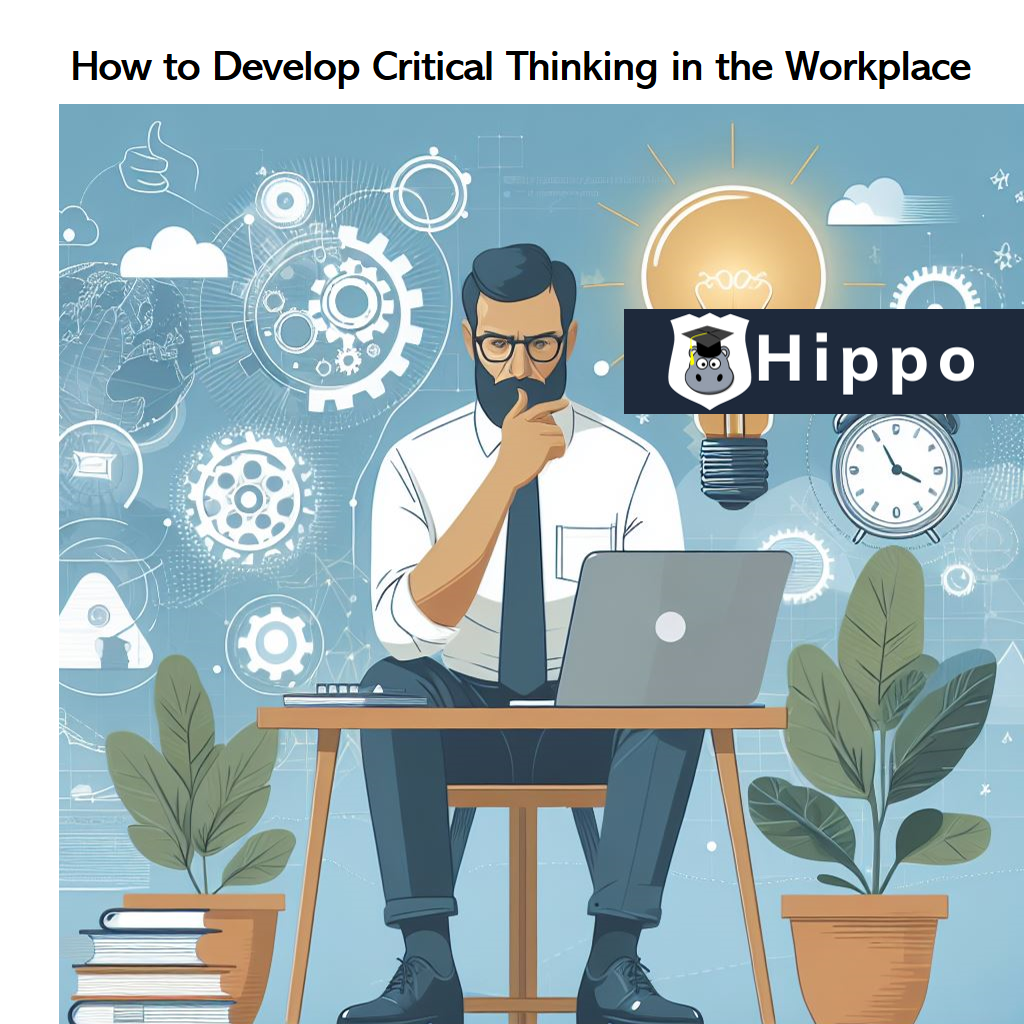In today’s rapidly changing business landscape, the ability to think critically is essential for success in the workplace. Critical thinking enables employees to analyze information, solve problems, make informed decisions, and adapt to new situations effectively. This blog will explore various aspects of developing critical thinking skills in the workplace, including understanding critical and creative thinking, assessing individual and team skills, creating an environment conducive to critical thinking, and continuously improving thinking practices.
Introduction to Critical Thinking in Others
Critical thinking is not only about individual skill development but also about fostering a culture of critical thinking within teams and organizations. By understanding the importance of critical thinking in others, leaders can create environments that encourage collaboration, innovation, and effective decision-making.
What is Critical Thinking
Critical thinking involves actively and skillfully conceptualizing, applying, analyzing, synthesizing, and evaluating information to reach a conclusion or solve a problem. It requires open-mindedness, logical reasoning, and the ability to consider multiple perspectives before making decisions.
What is Creative Thinking
Creative thinking complements critical thinking by encouraging innovative solutions and out-of-the-box ideas. It involves generating original concepts, making connections between seemingly unrelated concepts, and embracing experimentation and risk-taking.
How to be a Critical Thinker?
Becoming a critical thinker requires practice and continuous development. Individuals can enhance their critical thinking skills by asking probing questions, seeking evidence, considering alternative viewpoints, and being willing to revise their opinions based on new information.
Models of Critical and Creative Thinking
Various models of critical and creative thinking exist, providing frameworks for understanding and applying these skills. These models include problem-solving frameworks, decision-making models, and creativity techniques such as brainstorming and mind mapping.
Features of Critical Thinking Concepts and Approaches
Critical thinking concepts and approaches encompass various skills and attributes, including analysis, evaluation, interpretation, inference, explanation, and self-regulation. Understanding these features enables individuals to apply critical thinking effectively in different contexts.
Existing Workplace Objectives, Processes, and Resources
To develop critical thinking in the workplace, it’s essential to align objectives, processes, and resources with the promotion of critical thinking skills. This may involve integrating critical thinking into training programs, performance evaluations, and organizational strategies.
Characteristics of Organisational Learning Environments and Related Learning Systems
Organizational learning environments that support critical thinking foster a culture of curiosity, experimentation, and continuous improvement. These environments prioritize learning, collaboration, and knowledge sharing, enabling employees to develop and apply critical thinking skills effectively.
Legislative Requirements Relating to Workplace Procedures
Compliance with legislative requirements is essential in developing critical thinking in the workplace. Understanding relevant regulations and policies ensures that critical thinking practices align with legal and ethical standards.
Sources of Reliable Information Relevant to Workplace Procedures
Access to reliable information is crucial for informed decision-making and problem-solving. Identifying trustworthy sources and staying updated on industry trends and best practices empower employees to apply critical thinking effectively in their roles.
Features of Industry Best Practice Approach to Instruction on Critical and Creative Thinking Methods
Industry best practices for instruction on critical and creative thinking methods involve incorporating active learning techniques, case studies, simulations, and real-world applications. These approaches engage learners and facilitate the practical application of critical thinking skills.
Leading a Team and Individuals to Develop Critical and Creative Thinking Skills
Effective leadership plays a vital role in developing critical and creative thinking skills within teams and individuals. Leaders can foster a supportive environment, provide feedback and guidance, and empower employees to take ownership of their learning and development.
Assess Individual and Team Critical and Creative Thinking Skills
Assessing critical and creative thinking skills involves evaluating individuals’ ability to analyze information, think critically, and generate innovative solutions. This assessment helps identify strengths and areas for improvement and informs targeted development initiatives.
Research Models of Critical and Creative Thinking
Researching models of critical and creative thinking provides insights into different approaches and techniques for developing these skills. By understanding various models, organizations can tailor training programs to meet specific learning objectives.
Develop Questions to Identify Individual and Team Knowledge Gaps
Developing questions to identify knowledge gaps helps pinpoint areas where additional training or support is needed. These questions can focus on specific competencies, processes, or problem-solving scenarios relevant to the organization’s objectives.
Critical Thinking Questions Based on Experience of Others
Drawing on the experiences of others can provide valuable insights and perspectives for developing critical thinking skills. By asking thought-provoking questions and facilitating discussions, individuals can learn from each other’s successes and challenges.
How do you handle disagreements with peers and co-workers?
Handling disagreements requires effective communication, active listening, empathy, and problem-solving skills. Encouraging open dialogue and constructive conflict resolution strategies fosters a culture of collaboration and mutual respect.
Critical Thinking Interview Questions Based on Hypothetical Scenarios
Interviewing candidates using hypothetical scenarios assesses their ability to think critically, analyze complex situations, and propose viable solutions. These questions evaluate candidates’ decision-making processes, problem-solving skills, and adaptability.
Facilitate Formal and Informal Learning Opportunities for Addressing Identified Gaps
Facilitating formal training sessions, workshops, and informal learning opportunities supports the development of critical and creative thinking skills. Providing access to resources, mentoring, and peer-to-peer learning encourages continuous skill development.
Formal vs. Informal Learning
Formal learning involves structured training programs, courses, and certifications, while informal learning encompasses on-the-job experiences, self-directed learning, and peer collaboration. Both formal and informal learning methods contribute to the development of critical thinking skills.
Articulate Key Features of Critical and Creative Thinking Concepts to Relevant Personnel
Communicating key concepts and principles of critical and creative thinking to relevant personnel promotes understanding and buy-in. Clear communication ensures that employees are aware of expectations, objectives, and the importance of developing these skills.
Establish an Environment that Encourages the Application of Critical and Creative Thinking
Creating an environment that fosters critical and creative thinking involves promoting open communication, valuing diverse perspectives, and encouraging experimentation. Establishing psychological safety and a culture of innovation empowers employees to explore new ideas and approaches.
Analyse Current Organisational Systems to Identify Gaps or Barriers to Critical Thinking
Analyzing existing organizational systems helps identify barriers or inefficiencies that may hinder critical thinking. This analysis informs process improvements, resource allocation, and organizational changes to support the development of critical thinking skills.
Develop Processes that Create a Safe Environment for Critical and Creative Thinking Approaches
Developing processes that support critical and creative thinking involves implementing feedback mechanisms, promoting autonomy, and recognizing and rewarding innovative ideas. These processes facilitate experimentation and risk-taking while ensuring accountability and alignment with organizational goals.
Facilitate Opportunities for Team Members to Apply Critical Thinking Skills to Workplace Problems
Providing opportunities for team members to apply critical thinking skills to real-world problems enhances learning and skill development. Encouraging cross-functional collaboration, challenging assumptions, and fostering a culture of continuous improvement drives innovation and problem-solving.
Provide Feedback to Team Members on Performance of Tasks
Offering constructive feedback on performance encourages reflection, growth, and skill refinement. Providing specific, actionable feedback highlights areas of strength and areas for improvement, guiding individuals and teams toward higher levels of proficiency in critical thinking.
Monitor and Improve Thinking Practices
Continuous monitoring and evaluation of thinking practices enable organizations to identify areas for improvement and track progress over time. Regular feedback loops, performance metrics, and reflective practices support ongoing learning and development.
Collect and Analyze Feedback from Individuals and Teams on Critical and Creative Thinking Opportunities
Collecting and analyzing feedback from individuals and teams provides valuable insights into the effectiveness of critical thinking initiatives. Soliciting feedback through surveys, focus groups, and performance reviews informs decision-making and helps tailor development strategies to meet evolving needs.
Identify Additional Support Required for Teams and Individuals
Identifying additional support needs ensures that individuals and teams have access to the resources, training, and guidance necessary for success. Addressing gaps in skills, knowledge, or resources empowers employees to overcome challenges and achieve their full potential.
Develop Recommendations for Improvements in Future Learning Arrangements According to Relevant Legislation and Organisation Policies
Developing recommendations for future learning arrangements involves aligning training programs, resources, and policies with legislative requirements and organizational objectives. These recommendations promote compliance, efficiency, and effectiveness in developing critical thinking skills.
Developing critical thinking skills in the workplace is essential for navigating complex challenges, driving innovation, and achieving success. By understanding the principles of critical and creative thinking, assessing individual and team skills, and creating an environment that supports learning and growth, organizations can empower employees to thrive in today’s dynamic business environment.
References
Coleman, J. (2023, April 4). Critical thinking is about asking better questions. Harvard Business Review.
Fatmawati, A., Zubaidah, S., Mahanal, S., & Sutopo. (2019). Critical thinking, creative thinking, and learning achievement: How they are related. Journal of Physics: Conference Series, 1417, 012070.
Hupfer, S. (2019, October 30). Critical thinking skills for industry 4.0. Deloitte United States.
James, K., Brodersen, M., & Eisenberg, J. (2021). Workplace affect and workplace creativity: A review and preliminary model. Emotion and Performance, 169–194.
Rios, J. A., Ling, G., Pugh, R., Becker, D., & Bacall, A. (2020). Identifying critical 21st-century skills for workplace success: A content analysis of job advertisements. Educational Researcher, 49(2), 80–89.
Van Laar, E., Van Deursen, A. J., Van Dijk, J. A. G. M., & De Haan, J. (2019). Twenty-first century digital skills for the Creative Industries Workforce: Perspectives from industry experts. First Monday.



